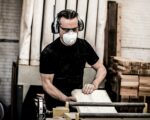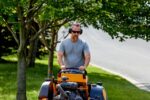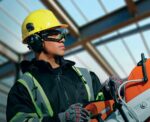When you imagine a chainsaw, the immediate dangers that come to mind revolve around the use of the saw, but damage to your hearing merits the same consideration and can be just as detrimental to your health long term as other accidents.
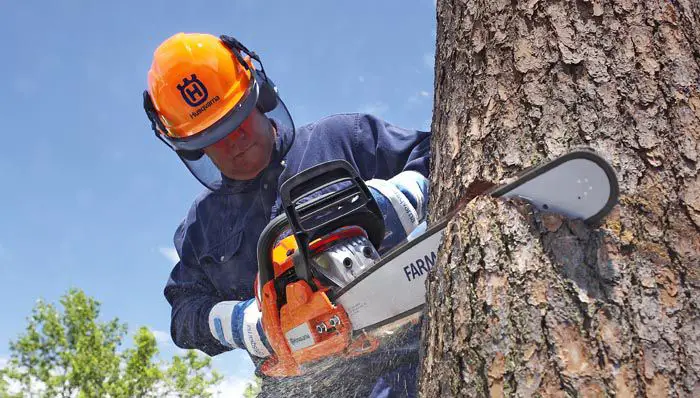
We asked several public works professionals, firefighters, and loggers, all of whom regularly use chainsaws to evaluate several ear protectors for us while on the job operating chainsaws.
Our top overall choice is Decibel Defense Professional Safety Earmuffs because we appreciated the NRR of 37 dB. When working with a large professional chainsaw, you will need the maximum noise attenuation possible, and these protectors offer among the highest NRRs on the market.
Comparison of Top Chainsaw Hearing Protectors
| Ear protection | Design | NRR | Extras | Material |
|---|---|---|---|---|
| Decibel Defense Professional Safety Earmuffs | Earmuffs | 37 dB | Many color options, Padded, foldable | Plastic, metal, foam |
| MPOW 035 Ear Muffs | Earmuffs | 28 dB | Double shell design, Carry pouch | Two layers of foam cushioning |
| Surefire EP4 Protective Sonic Defenders | Earplugs with patented locking position | 24 dB with noise reduction filter | Reusable, Can be worn with helmet, mask, or hat | Medical-grade polymers |
| Fnova Safety Ear Muffs Ear Defenders | Earmuffs | 34 dB | Adjustable foldable headband | Foam cushioning |
| 3M Peltor X5A Safety Earmuffs | Earmuffs | 31 dB | Cut out headband, Replaceable ear cushions | Earcups in ABS |
Regardless of your profession, protecting your health is a priority. If you are a professional that uses power tools for your job or even a DIY-er that uses power tools for home improvement projects, you should know that most power tools can damage your hearing, particularly when used daily. This is especially true if you use a chainsaw.
Detailed Review of Ear Protectors for Chainsaw
1. Decibel Defense Professional Safety Earmuffs
- Industry leading NRR 37 dB protection.
- Safe and comfortable for adults and kids
- ANSI S3.19 & CE EN 352-1 Certified
Prices pulled from the Amazon Product Advertising API on:
Product prices and availability are accurate as of the date/time indicated and are subject to change. Any price and availability information displayed on [relevant Amazon Site(s), as applicable] at the time of purchase will apply to the purchase of this product.
These earmuffs are our top choice as defenders thanks to the exceptional NRR of 37 dB. They boast an adjustable cushioned headband and a foldable design for easy transport.
They are lightweight making them ideal for long work shifts. Comfort is a priority with these ear protectors but not at the cost of hearing protection.
Pros
-
-
- NRR 37
- Nice design
- Affordable
- Comfortable for long work shifts with heavy power tools
-
Cons
-
-
- Difficulty reported in blocking low-frequency noise
-
2. Mpow 035 Noise Reduction Safety Ear Muffs
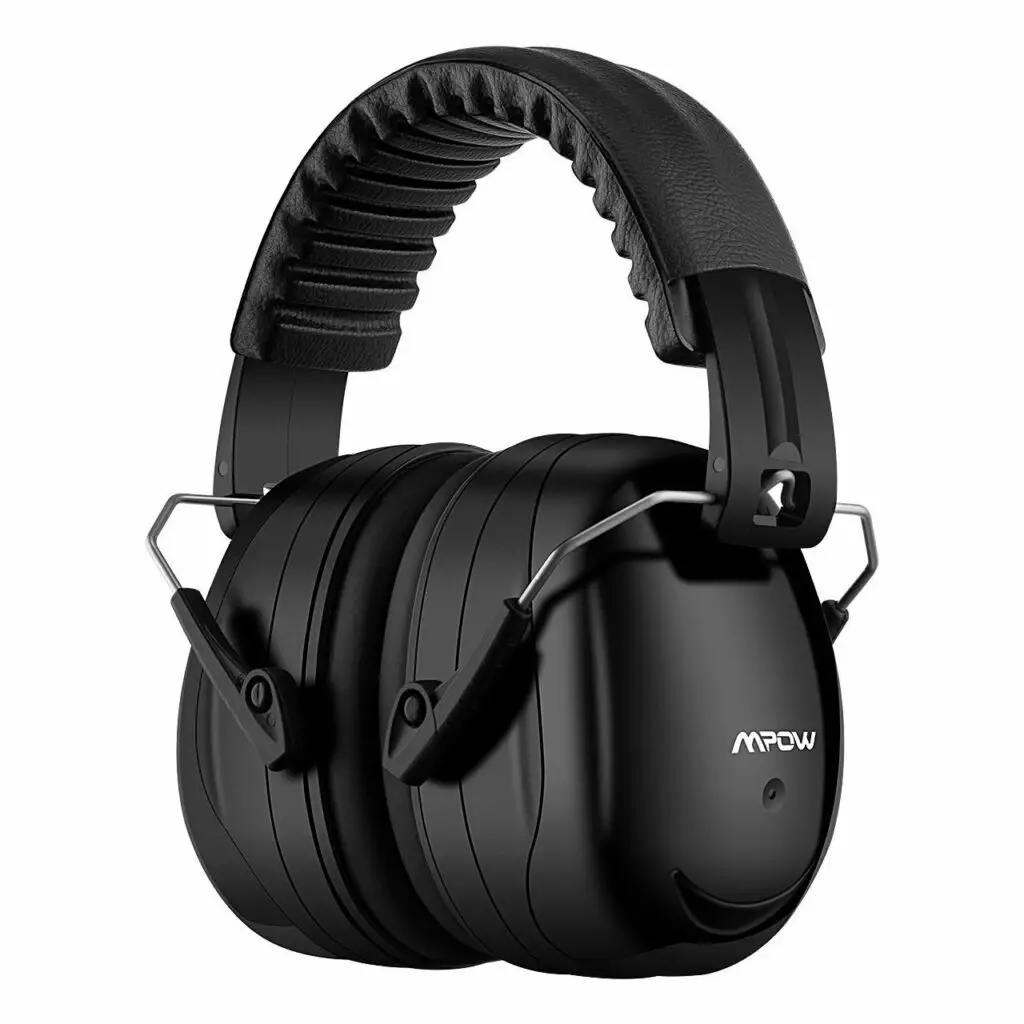
Our top runner-up choice is the Mpow 035 protective earmuff defenders because these protectors offer great comfort for a good price.
These muffs have a headband that is ribbed which helps to reduce heat buildup when you’re busy working with a chainsaw during the summer heat or in direct sunlight.
Lightweight at 9.9 ounces they offer two layers of acoustic foam for the noise. Their foldable style makes them very compact with the ear cups that fold into the headband for easy transport.
Pros
-
-
- Double Shell design
- NRR 28 dB
- compact design
- Carry pouch
- Affordable
-
Cons
-
-
- Don’t offer great protection for high dB noise
- May not be ideal in size for larger heads
-
3. Surefire EP4 Protective Sonic Defenders
- 24dB Noise Reduction Rating (NRR)
- Soft, adjustable, triple-flanged stems
- Low-profile design
- Patented EarLock retention rings
- Made in USA from hypoallergenic
Prices pulled from the Amazon Product Advertising API on:
Product prices and availability are accurate as of the date/time indicated and are subject to change. Any price and availability information displayed on [relevant Amazon Site(s), as applicable] at the time of purchase will apply to the purchase of this product.
If you prefer an earplug design as opposed to ear muffs these SureFire Plugs are an attractive alternative. They have a nice design that permits you to wear them with a helmet, mask, or hat.
The earplugs can be locked into position so that they fit the same way every time you wear them thanks to the SureFire patented locking system.
They also can be worn under earmuffs in case you want added protection. They boast soft stems for comfort with seals to secure inside the ear canal.
Made in the USA, they are constructed with medical-grade polymers to avoid allergic reactions. They have an NRR of 24dB, so check out your environmental noise.
Great for homeowners using chainsaws for home improvement projects. They do offer a noise filter that reduces noises above 85 dB.
Pros
-
-
- Convenient
- Portable
- Made to avoid allergic reactions
- Can be worn with helmets, etc.
- Patented locking system for positioning
-
Cons
-
-
- NRR 24 dB could be higher
- Some fit problems
-
4. Fnova Safety Ear Muffs Ear Defenders
- 34dB – Highest NRR ear defenders
- Portable size for for efficient storage
- Design adjustment headband
- Industrial grade premium quality
Prices pulled from the Amazon Product Advertising API on:
Product prices and availability are accurate as of the date/time indicated and are subject to change. Any price and availability information displayed on [relevant Amazon Site(s), as applicable] at the time of purchase will apply to the purchase of this product.
These Ear defenders have an outstanding NRR of 34 dB. The superb ear protection is thanks to the construction with sound absorption material including two layers of foam inside a solid ear cup that work together to seal your ear from environmental noise.
A padded headband along with the foam-cushioned cups guarantee comfort and the adjustable headband ensures a good fit.
So, for pros that work long hours with a chainsaw in hand, have no worries. The compact design with a headband that is foldable makes for easy transport. A very convincing pair of ear defenders.
Pros
-
-
- NRR 34 dB
- Adjustable foldable headband
- Padding for comfort
- Durable
- Easy transport
-
Cons
-
-
- Some concern about total noise reduction
-
5. 3M Peltor X5A Safety Earmuffs
- High attenuation
- Advanced Technologies
- Extended comfort
- Durable
- Dielectric headband
- REPLACEABLE CUSHIONS
Prices pulled from the Amazon Product Advertising API on:
Product prices and availability are accurate as of the date/time indicated and are subject to change. Any price and availability information displayed on [relevant Amazon Site(s), as applicable] at the time of purchase will apply to the purchase of this product.
These protective earmuffs have a high NRR of 31 dB offering great noise attenuation. They boast spacers with nicely designed ear cups and innovative effective foam cushioning.
A nice effective acoustic seal is achieved over your ears while you are maximizing comfort thanks to a cut-out headband design for hot climates. Ear cups are made in durable ABS. The ear cushions are replaceable.
Pros
-
-
- NRR of 31 dB
- Foam ear cushions are replaceable
- Very comfortable
- Headband design for hot climates
-
Cons
-
-
- Tight fit reported by some clients
- Heavy for some buyers
-
Levels of Noise in Different Work Conditions
Levels of noise in the workplace are measured in decibels often indicated as dB. If you are exposed constantly to levels above 85 dB, your hearing can be damaged beyond repair. Consider this chart to get an idea of the risks to your hearing that are present in all sorts of daily situations.
| Decibels | How long it is safe to listen without any ear protection | Type or source of the Noise |
| 130 | 0 | Jet lift off |
| 120 | 0 | Amplified musical event |
| 115 | Under one minute | Sporting event |
| 109 | Under two minutes | Use of auto horn |
| 106 | Under four minutes | Personal music source set at the maximum volume |
| 100 | Fifteen minutes | Industrial machinery |
| 97 | Half hour | Motorcycle noise |
| 94 | One hour | Electric drill |
| 91 | Two hours | Lawnmower noise |
| 85 | Eight hours | Vacuum cleaner noise |
| 55 | Always safe | Normal conversation without shouting |
If you imagine that a rock concert can amplify music up to as much as 150 dB, professional chainsaws can create noise that reaches 120 dB and a chainsaw sold for home use can produce as much as 100 dB of noise. So, the use of this specific power tool should never be underestimated when considering the health of your hearing.
OSHA recommended noise limit
Noise levels above 85 dB in the work environment are considered to be harmful and potentially damaging to hearing by OSHA (Occupational Safety and Health Administration). For this reason, they recommend that hearing protection be used if the noise levels exceed 85 dB.
Considering that a chainsaw can produce sounds as loud as 120 dB, well above this limit, hearing protection is necessary, and we recommend that hearing protection be used with all power tools, electric saws included.
See also: Best Hard Hat Earmuffs
Why its important to wear ear protectors while using chainsaw?
Hearing loss is a gradual process, and you may not realize that you have already endured some. There are warning signs that you should be aware of like noises seeming muffled, needing to increase the volume on your tv or radio, or just having difficulty hearing what people are saying when conversing.
If you ignore any of these signs and continue to work without hearing protection, you may end up using hearing aids in a best-case scenario, or at the worst, you may lose your hearing altogether.
Spending some money for hearing protection is very little to ask in exchange for lifelong healthy hearing. Now let’s consider what you should keep in mind when selecting and purchasing your hearing protectors.
Basics to Consider when Selecting Hearing Protection
Noise Attenuation. This process is how noise energy is diminished or lost. When choosing your ear protectors, it is fundamental to know exactly how much noise attenuation they offer. The letters “NRR” mean “Noise Reduction Rating”.
This value will indicate the amount of noise attenuation offered by the protectors you want to buy. To understand how much acoustic pressure your ears sustain, the NRR should be subtracted from the average noise level that has been measured in your workplace.
If the average sound level measures about 90 dB and your ear protectors have an NRR of 30, the average acoustic pressure you experience with the protectors on will be 90 – 30 = 60 decibels. A higher NRR will guarantee better the noise attenuation will be with your ear protectors on.
The letters “HML” represents the procedure for approximating how much attenuation ear protectors offer concerning three different parameters of High, Medium, and Low. These parameters refer specifically to the amount of noise reduction at these differing frequencies.
NRR or Noise Reduction Rating. This is the most important piece of information for selecting hearing protection. This number indicates exactly how much protection the protectors provide. The higher the number, the greater reduction of unwanted noise.
Environmental Noise in the Workplace. It is necessary to know the amount of environmental noise that you will be subject to where you work. Also, consider the type of power tools that you use when working.
The correct hearing protection must be selected for the amount of environmental noise you sustain daily. Better to invest a little more money in a top-notch pair of hearing protectors.
Certification. All PPE, which includes ear defenders, ought to meet international and national standards required by law. Markings used on PPE such as CE, EN ISO, and BS will indicate if the equipment meets safety standards for both performance and design.
There is more than one standard for varying types of noise. EN60745 markings refer to portable power tools noise while BS EN ISO 4871-2009 refers to machinery noise.
The USA Noise Reduction Rating – NRR, the British Standards Institution – BSI, and the European Union – CE indicate measurement units as to how effective the ear protectors you want to buy are.
See also: Best hearing protectors for construction workers
Things to Consider while Buying Ear Protectors
1.) Fit and Comfort. If at all possible, you should try on your ear protectors before purchasing them. Trying will help you decide if the fit is correct, and the fit is a contributing factor for your comfort.
If you are a pro who works all day and wear ear protection for extended periods, your ear protectors must be comfortable. You won’t wear them after a while if they hurt your ears or head giving you a headache.
A headband that is adjustable and features cushioning is an important feature for prolonged comfort during an entire workday. Earplugs are often a less expensive option, but they are inserted into the ear.
They may not be comfortable for everyone. Good ear protection should feature padding or cushion of some sort, and if it is replaceable, all the better.
2.) Durability. You want to have ear protectors that last longer than a few weeks or even a couple of months. Read customer feedback to understand the potential durability of a product with proper care. Note if the manufacturer offers some type of warranty.
3.) Cost. A budget-friendly choice is important when purchasing but so is quality when it comes to your health. Your priority is good protection, and this may mean paying a bit more.
Do not buy a pair of ear protectors because they are cheap or low cost. Your hearing is priceless and needs to last for your entire lifetime.
4.) Brand/Manufacturer. The most reputable brands will instill confidence. If you haven’t a favorite PPE brand, ask colleagues, read critiques and reviews like this one, and read customer feedback before making your final choice.
A Final Thought
Chainsaws are just loud! So, if you are one of the many professionals using a chainsaw regularly at work, or a home improvement aficionado, you need protection for your hearing.
Regardless of whether you are a pro or work with chainsaws for personal reasons, you know that the noise can be deafening.
This can cause permanent damage to your hearing, so we recommend spending some of your hard-earned cash on vital ear protection.
We hope this article will get you started on your search. Thank you for reading and good hunting for those perfect ear defenders.






